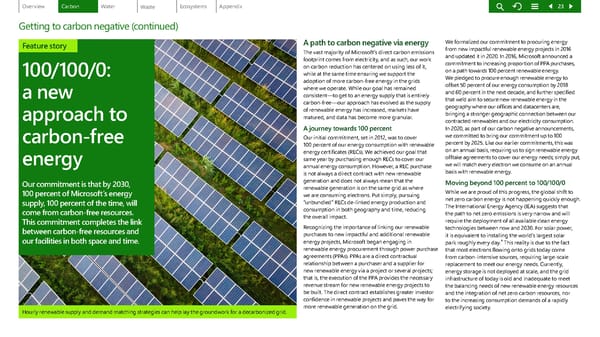Feature story 100/100/0: a new approach to carbon-free energy Our com mitment is that by 2030, 100 percent of Microsoft’s energy supply, 100 percent of the time, will come from carbon-free resources. This commitment completes the link between carbon-free resources and our facilities in both space and time. Hourly renewable supply and demand matching strategies can help lay the groundwork for a decarbonized grid. 23 Getting to carbon negative (continued) A path to carbon negative via energy The vast majority of Microsoft’s direct carbon emissions footprint comes from electricity, and as such, our work on carbon reduction has centered on using less of it, while at the same time ensuring we support the adoption of more carbon-free energy in the grids where we operate. While our goal has remained consistent—to get to an energy supply that is entirely carbon-free—our approach has evolved as the supply of renewable energy has increased, markets have matured, and data has become more granular. A journey towards 100 percent Our initial commitment, set in 2012, was to cover 100 percent of our energy consumption with renewable energy certificates (RECs). We achieved our goal that same year by purchasing enough RECs to cover our annual energy consumption. However, a REC purchase is not always a direct contract with new renewable generation and does not always mean that the renewable generation is on the same grid as where we are consuming electrons. Put simply, pursuing “unbundled” RECs de-linked energy production and consumption in both geography and time, reducing the overall impact. Recognizing the importance of linking our renewable purchases to new impactful and additional renewable energy projects, Microsoft began engaging in renewable energy procurement through power purchase agreements (PPAs). PPAs are a direct contractual relationship between a purchaser and a supplier for new renewable energy via a project or several projects; that is, the execution of the PPA provides the necessary revenue stream for new renewable energy projects to be built. The direct contract establishes greater investor confidence in renewable projects and paves the way for more renewable generation on the grid. We formalized our commitment to procuring energy from new impactful renewable energy projects in 2016 and updated it in 2020. In 2016, Microsoft announced a commitment to increasing proportion of PPA purchases, on a path towards 100 percent renewable energy. We pledged to procure enough renewable energy to offset 50 percent of our energy consumption by 2018 and 60 percent in the next decade, and further specified that we’d aim to secure new renewable energy in the geography where our offices and datacenters are, bringing a stronger geographic connection between our contracted renewables and our electricity consumption. In 2020, as part of our carbon negative announcements, we committed to bring our commitment up to 100 percent by 2025. Like our earlier commitments, this was on an annual basis, requiring us to sign renewable energy offtake agreements to cover our energy needs; simply put, we will match every electron we consume on an annual basis with renewable energy. Moving beyond 100 percent to 100/100/0 While we are proud of this progress, the global shift to net zero carbon energy is not happening quickly enough. The International Energy Agency (IEA) suggests that the path to net zero emissions is very narrow and will require the deployment of all available clean energy technologies between now and 2030. For solar power, it is equivalent to installing the world’s largest solar park roughly every day. 4 This reality is due to the fact that most electrons flowing onto grids today come from carbon-intensive sources, requiring large-scale replacement to meet our energy needs. Currently, energy storage is not deployed at scale, and the grid infrastructure of today is old and inadequate to meet the balancing needs of new renewable energy resources and the integration of net zero carbon resources, nor to the increasing consumption demands of a rapidly electrifying society.
 Environmental Sustainability Report | Microsoft Page 22 Page 24
Environmental Sustainability Report | Microsoft Page 22 Page 24